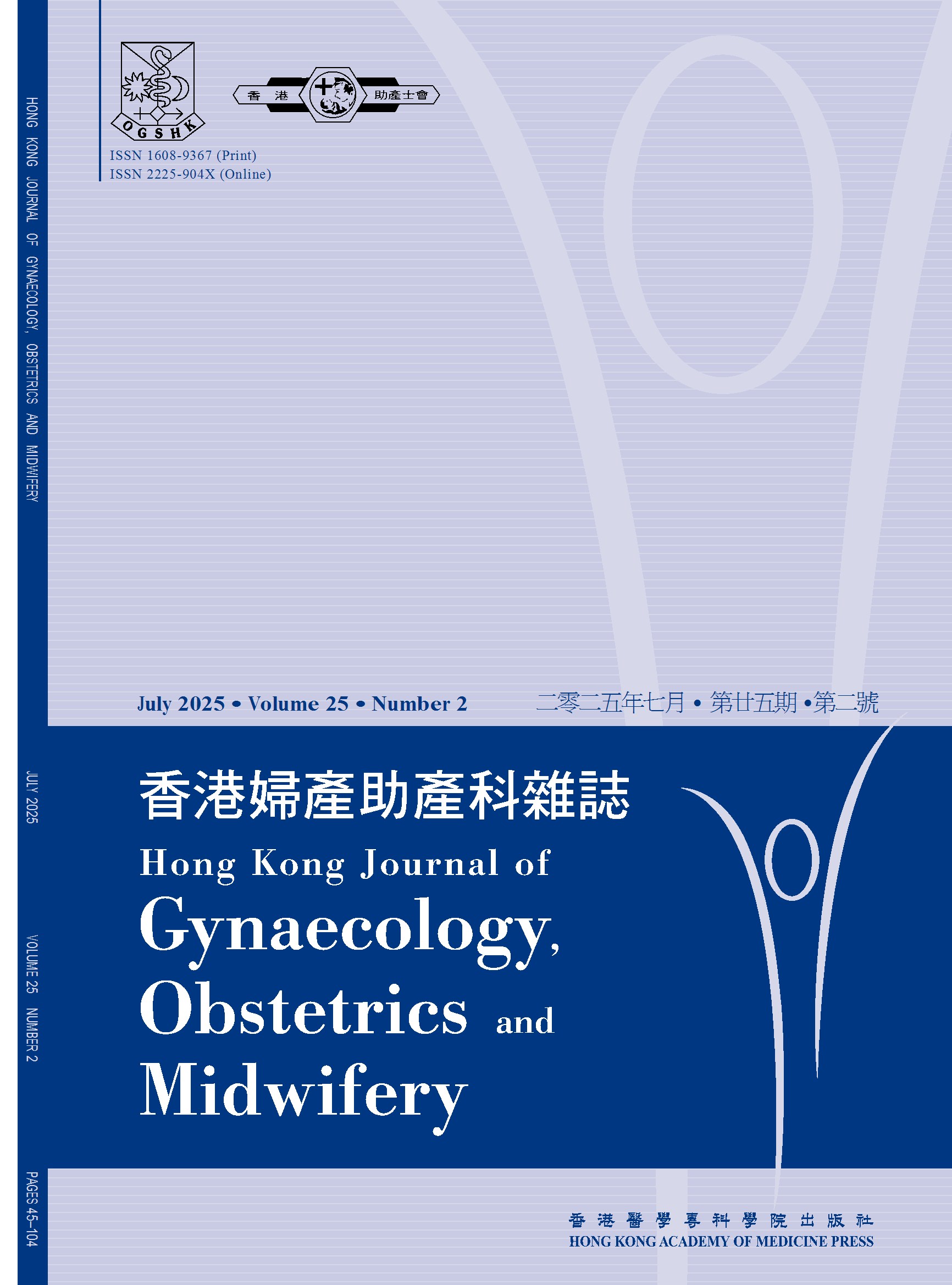Extended follow-up of a single standardised dose of intravenous iron therapy for severe iron-deficiency anaemia in women with heavy menstrual bleeding: a single-centre retrospective study
Keywords:
Anemia, iron-deficiency, Iron isomaltoside 1000, MenorrhagiaAbstract
Objective: To investigate the extended outcomes of a single standardised dose of intravenous (IV) iron therapy for severe iron-deficiency anaemia in women with heavy menstrual bleeding (HMB).
Methods: Medical records were retrospectively reviewed in women with severe iron-deficiency anaemia (defined as a haemoglobin [Hb] level of 6-8 g/dL) secondary to HMB who received a single dose of 500 mg IV iron isomaltoside, followed by daily oral iron supplement for 10 weeks between January 2020 and June 2021 at Kwong Wah Hospital. Outcome measures included changes in Hb levels at different time points within 1 year and any hypersensitivity event.
Results: In total, 155 women aged 21 to 55 years with a diagnosis of HMB without an identifiable structural cause (n=48), leiomyoma (n=75), adenomyosis (n=31), or endometrial hyperplasia (n=1) were included in the analysis. They received 159 infusions during the study period. The median Hb level was 7.1 g/dL before treatment and increased to 10.9 g/dL at 3 months and 10.7 g/dL at 6 months (p<0.001 for both). At the 1-year follow-up, the median Hb level was 9.8 g/dL among 25 patients (p<0.001) and 11 g/dL among 19 patients who complied with the treatment (p=0.001). Only 15 women had a recurrence of severe anaemia within 1 year. Moreover, 16 women experienced mild (n=13) or moderate (n=3) hypersensitivity to IV iron therapy, which presented as an urticarial rash and shortness of breath, respectively.
Conclusion: IV iron therapy is an integral component of patient blood management among women with iron-deficiency anaemia secondary to HMB, effectively preventing recurrence of severe anaemia and maintaining Hb levels for up to 1 year. This provides a window for clinicians to investigate the underlying gynaecological conditions and to optimise definite treatment.
References
1. World Health Organization. Anaemia in women and children. 2021. Accessed 20 October 2024. Available from: https://www.who.int/data/gho/data/themes/topics/anaemia_in_women_and_children
2. Centre for Health Protection. Population Health Survey 2020-22 Thematic Report on Iron Status. Accessed 20 October 2024. Available from: https://www.chp.gov.hk/files/pdf/dh_phs_2020-22_iron_report_eng.pdf
3. Fraser IS, Mansour D, Breymann C, Hoffman C, Mezzacasa A, Petraglia F. Prevalence of heavy menstrual bleeding and experiences of affected women in a European patient survey. Int J Gynaecol Obstet 2015;128:196-200.
4. Litton E, Xiao J, Ho KM. Safety and efficacy of intravenous iron therapy in reducing requirement for allogeneic blood transfusion: systematic review and meta-analysis of randomised clinical trials. BMJ 2013;347:f4822.
5. Derman R, Roman E, Modiano MR, Achebe MM, Thomsen LL, Auerbach M. A randomized trial of iron isomaltoside versus iron sucrose in patients with iron deficiency anemia. Am J Hematol 2017;92:286-91.
6. Auerbach M, Henry D, Derman RJ, Achebe MM, Thomsen LL, Glaspy J. A prospective, multi-center, randomized comparison of iron isomaltoside 1000 versus iron sucrose in patients with iron deficiency anemia; the FERWON-IDA trial. Am J Hematol 2019;94:1007-14.
7. Lau SCH, Hung CMW, Leung WC, Leung TW. Intravenous iron therapy for menorrhagic patients with severe iron-deficiency anaemia: a retrospective cohort study. Hong Kong J Gynaecol Obstet Midwifery 2019;19:103-6.
8. Derman R, Roman E, Smith-Nguyen GN, Achebe MM, Thomsen LL, Auerbach M. Iron isomaltoside is superior to iron sucrose in increasing hemoglobin in gynecological patients with iron deficiency anemia. Am J Hematol 2018;93:E148-E150.
9. Mishra V, Verneker R, Gandhi K, Choudhary S, Lamba S. Iron deficiency anemia with menorrhagia: ferric carboxymaltose a safer alternative to blood transfusion. J Midlife Health 2018;9:92-6.
10. Avni T, Bieber A, Grossman A, Green H, Leibovici L, Gafter-Gvili A. The safety of intravenous iron preparations: systematic review and meta-analysis. Mayo Clin Proc 2015;90:12-23.
11. Camaschella C. Iron-deficiency anemia. N Engl J Med 2015;372:1832-43.
12. Short MW, Domagalski JE. Iron deficiency anemia: evaluation and management. Am Fam Physician 2013;87:98-104.
13. Hospital Authority. Guideline on iron therapy. 2021.
14. Rampton D, Folkersen J, Fishbane S, et al. Hypersensitivity reactions to intravenous iron: guidance for risk minimization and management. Haematologica 2014;99:1671-6.
15. Lethaby A, Puscasiu L, Vollenhoven B. Preoperative medical therapy before surgery for uterine fibroids. Cochrane Database Syst Rev 2017;11:Cd000547.
16. Girelli D, Ugolini S, Busti F, Marchi G, Castagna A. Modern iron replacement therapy: clinical and pathophysiological insights. Int J Hematol 2018;107:16-30.
17. Stoffel NU, von Siebenthal HK, Moretti D, Zimmermann MB. Oral iron supplementation in iron-deficient women: How much and how often? Mol Aspects Med 2020;75:100865.
18. Karczewski M, Simic S, Saleh L, et al. The magnitude of the plasma hepcidin response to oral iron supplements depends on the iron dosage. Swiss Med Wkly 2024;154:3635.
19. Mulder MB, van den Hoek HL, Birnie E, van Tilburg AJP, Westerman EM. Comparison of hypersensitivity reactions of intravenous iron: iron isomaltoside-1000 (Monofer®) versus ferric carboxy-maltose (Ferinject®). A single center, cohort study. Br J Clin Pharmacol 2019;85:385-92.
Downloads
Published
How to Cite
Issue
Section
License
Copyright (c) 2025 Hong Kong Journal of Gynaecology, Obstetrics and Midwifery

This work is licensed under a Creative Commons Attribution-NonCommercial-NoDerivatives 4.0 International License.
The Journal has a fully Open Access policy and publishes all articles under a Creative Commons Attribution-NonCommercial-NoDerivatives 4.0 International (CC BY-NC-ND 4.0) licence. For any use other than that permitted by this license, written permission must be obtained from the Journal.





